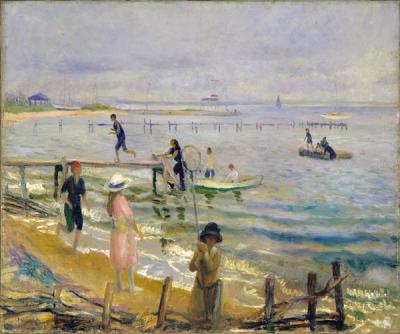William Glackens: Scenes by the Shore

The Parrish Art Museum in Water Mill will present the first comprehensive survey since 1966 of the work of William Glackens from Sunday through Oct. 13. Spanning the artist’s career from the 1890s through the 1930s, the exhibition will include more than 70 paintings and works on paper from important public and private collections, including those of the Metropolitan Museum of Art, the National Gallery of Art, and the Cleveland Museum.
Organized by Avis Berman, a writer and art historian who will lead a tour of the show on Sunday at 11 a.m., “William Glackens” explores the variety of motifs found in the artist’s work. His landscapes range from the urban spectacle of New York City to the beaches of Cape Cod and Bellport. He was also a master of still lifes, portraits, and figure studies.
Born in Philadelphia in 1870, Glackens studied at the Pennsylvania Academy of Fine Arts, where he became friends with Robert Henri, George Luks, Everett Shinn, and John Sloan. The five painters formed the core of the group known as The Eight.
“The William Glackens exhibition presents an extraordinary opportunity to observe the artist’s entire career,” according to Alicia Longwell, the museum’s chief curator. “Scenes of daily life were the hallmark of The Eight, and it was Glackens’s brilliance to realize an art of depth and distinction from such commonplace subject matter. It was to scenes by the shore that he returned again and again and the paintings in the exhibition from the Bellport years brilliantly show this high point in his quest for an art that would convey not only observation but sensation.”
While his early work was influenced by Henri in its muted colors and gestural brushstrokes, Glackens, inspired by visits to Europe, later turned to outdoor scenes, using bright, lively colors. His change in style was reinforced by frequent trips to France, and his mature style suggests Monet’s paintings of the 1860s.
Glackens was on the selection committee of the 1910 Exhibition of Independent Artists, the first large-scale invitational show of progressive artists, and was chairman of the American section of the Armory Show, which introduced European vanguard art to this country in 1913. With these roles Glackens became a powerful advocate for landmark exhibitions of the American and European avant-garde.
As an advisor to Albert C. Barnes, the Philadelphia chemist who became a self-made millionaire in the early 20th century, Glackens traveled to Paris on a buying trip in 1912 and returned with works by Paul Cézanne, Maurice Denis, Vincent van Gogh, Pablo Picasso, Camille Pissarro, and Pierre Auguste Renoir. These purchases became the nucleus of the Barnes Foundation collection.
A fully illustrated catalog, edited by Ms. Berman and including an essay by Dr. Longwell titled “Scenes at the Shore: Glackens’s Summers by the Sea,” accompanies the exhibition, which will travel to the Barnes Foundation in November.


